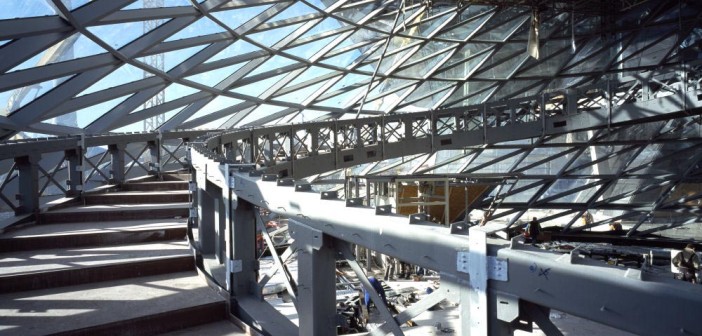The steel industry, along with the rest of the construction industry, was badly crippled by the 2008 recession, but now is beginning to show signs of recovery. The New York Times, for example, reported on the turn around signs of ArcelorMittal, a major international steel company.* While this recent economic advancement is good news, the steel industry is advancing in another more important way too- technologically. For over 150 years, steel has been a major force and indicator in the world’s industrialized economies, and technological improvements in steel production always bring welcome coat tail effects. First came Bessemer’s process in late 1800s which revolutionized ship plates and locomotive rail production. Then came the open hearth method of purification which allowed greater control over the elemental make-up of the steel and made it easier to include more scrap metal in the load. Next a plunge in electricity costs led to the switch from the crucible to the electric arc furnace in steel production by the 1920s. After that, the 1960s witnessed the switch to the blow oxygen furnace which sped up the process of steel making till in one hour huge loads of molten iron mixed with scrap steel were regularly converted to brand new steel, and all done more efficiently. The great news is that this history of technological advancement is continuing today.
The New Super Steel
A race between Britain and America to produce a steel 70% stronger than any steel ever seen in the past has of late been won by the United States. This steel is cheaper to make and testing is still under way to see if it be fit for use in shielding a nuclear fusion reactor. The heat and radiation from the planned “self-burning plasma” would subject the steel to 100 million degrees.
We talked with Vacro Pruden Buildings who explained that what makes this steel so super is the removal of tiny imperfections that in the past could not be gotten rid of. This strengthens the internal magnetic structure of the mass and increases resistance to heat and radiation.
The New Corrosion Resistant Steel
Another new breakthrough is “enhanced steel” that is about twice as strong as normal steel and five times as resistant to corrosion. This steel is already approved for California bridge projects. The added strength means less steel rebar is needed, and the added anti-corrosive properties ensure a longer life to the steel and to the bridges.
All the places traditional rebar was used, and more, can now be filled with steel instead. A 100 year life span with less maintenance needed could result in lower costs and less traffic congestion. And not only bridges, but retaining walls, and buildings of all kinds can potentially benefit from this new technology.
Greener Steel
In 2013, Worldsteel introduced a new method for measuring the intensity of carbon dioxide emissions at steel and iron production plants. This tool helps to monitor the progress in reduction of greenhouse gases already begun in the steel industry. The new high strength steels that are coming out allow for less steel to be used in automobiles, building construction, and in general without sacrificing strength. This means less production needed and less emissions- perhaps as much as a 70% fall in emission rates. Greater efficiency has in this case accompanied the pursuance of environmental concerns.#*
The history of steel is a fascinating study that takes us from the dawn of the industrial revolution and into the present time, and from swords to train rails to nuclear plants. It is an unfinished history that has gained new life of late by the discovery of several new scientific methods for the production of stronger, less corrosive, and less environmentally controversial steel making methods. We have all benefited from the past advancements of steel, and we are sure to reap the harvest of a new series of steel technologies.
*www.nytimes.com/2014/05/10/business/loss-narrows-for-steelmaker-arcelormittal.html?_r=0
**en.wikipedia.org/wiki/Steel_industry,_history
#metals.about.com/od/properties/a/A-Short-History-Of-Steel-Part-Ii.htm
##www.dailytech.com/US+Beats+Britain+to+Fusion+Super+Steel/article13296.htm#sthash.ZNMJ3pyt.dpuf
*#news.thomasnet.com/IMT/2008/11/11/5-major-high-tech-advancements-in-materials-science-tech/ & www.mmfx.com/news/caltrans-new-pilot-program-expands-use-astm-a1035/
#*www.worldsteel.org/steel-by-topic/sustainable-steel/environmental.html




